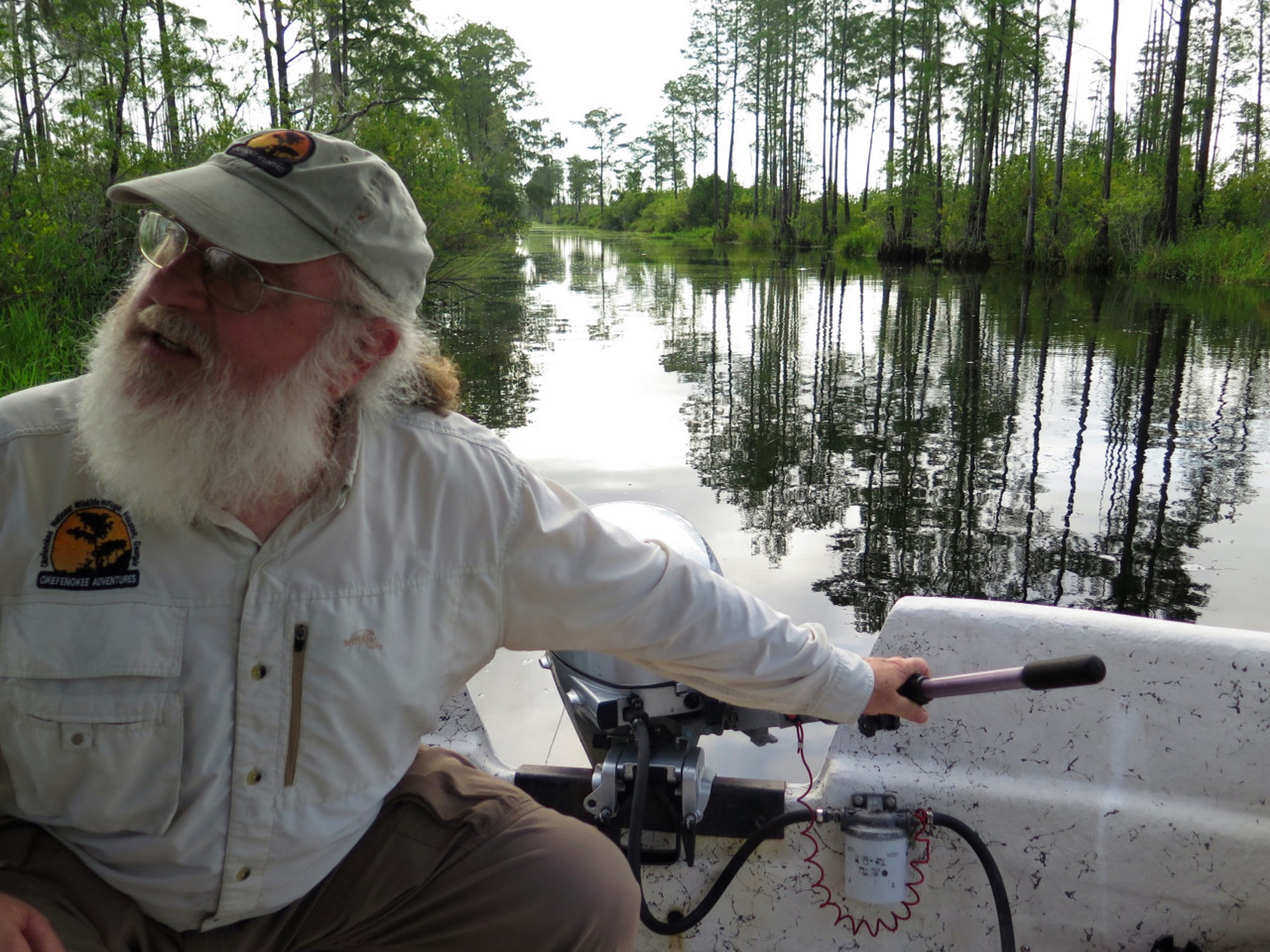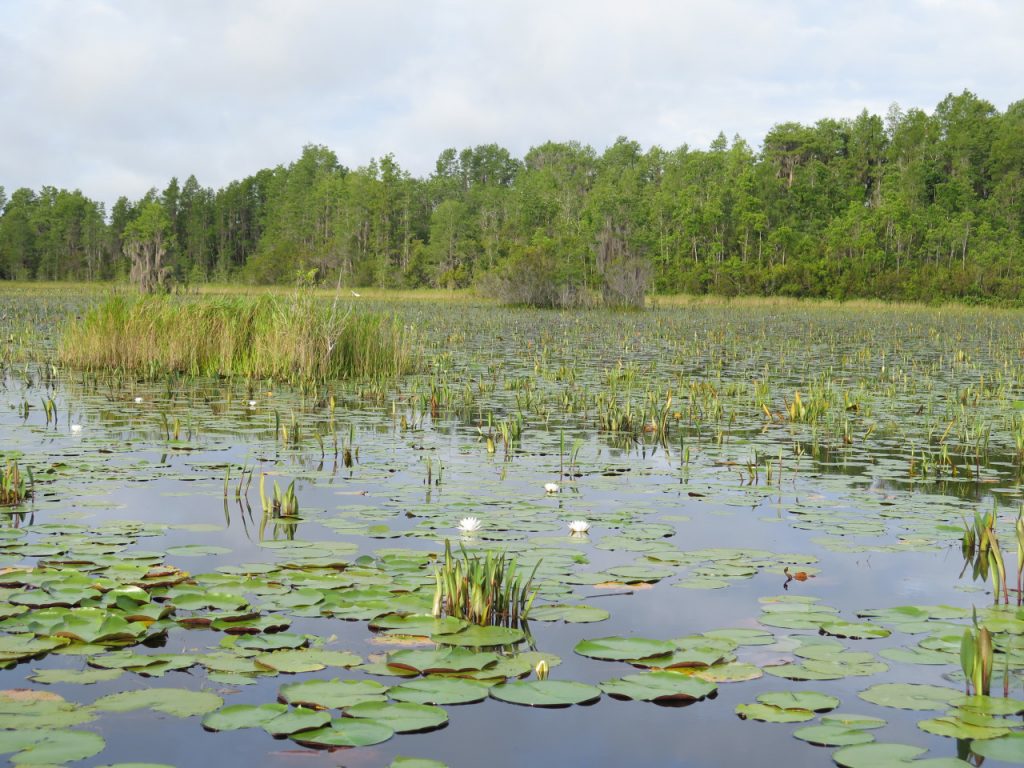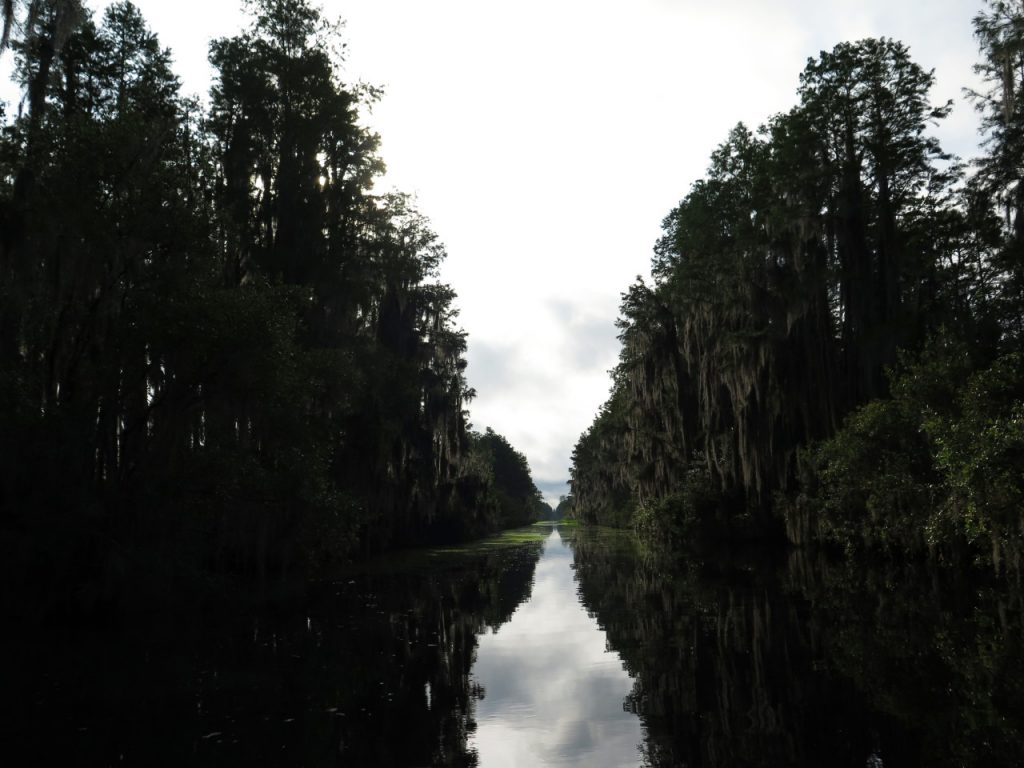A Familiar Story, Different Details: The Latest Proposal To Mine The Okefenokee

Chip Campbell navigates Okefenokee National Wildlife Refuge. “It’ll capture your heart,” Campbell said of the swamp.
Emma Hurt / WABE
South Georgia is home to one of the largest freshwater wetlands in North America: the Okefenokee National Wildlife Refuge.
There’s a new plan to mine for titanium nearby, which environmentalists aren’t happy about. It reminds many of a similar fight for the swamp 22 years ago. Back then? The federal government stepped in to stop a 38,000-acre mining proposal by Du Pont.
But this time around, that’s unlikely to happen. The Trump administration has said finding domestic sources for minerals like titanium is a national security priority.
Okefenokee, which is said to mean “bubbling water” in Muscogee, features fields of lily pads and water lilies, cypress trees draped in Spanish moss, mirror-like black water, stained from the swamp’s plants and trees. It’s almost totally free of light pollution, or the noise of civilization.
Michael Lusk manages the refuge for the U.S. Fish and Wildlife Service. He said that’s what people are looking for: “One of the reasons for sure that people come to visit the Okefenokee is because it’s so big and wild, and quiet and dark. All those wonderful things that you just can’t get many places anymore.”

Chip Campbell and his wife Joy visited the swamp on their honeymoon.
While at first, that might not sound like the most romantic spot, he said, the typical swamp connotation doesn’t necessarily fit.
“A lot of people come to the swamp and they think it’s going to be this dark, overhung, gloomy kind of place. And there’s parts of Okefenokee that have some of that, but a lot of it is like this — it’s very open, sun-splashed,” he said.
Now they own the only private concession company in the refuge and see many of its 600,000 annual visitors.
“It’ll capture your heart,” Campbell said of the swamp. “That black water will get into your blood.”
And of course, there are the alligators. How many?
“It’s hard to say,” he said. “You can’t get them to fill out a census form, you know. There’s a bunch of them. Whether it’s 15,000, 20,000, 25,000.”
The swamp is about half the size of Rhode Island, and most of it is not accessible by boat or helicopter.
“This is one of the last big swaths of genuine wilderness left in the Eastern United States,” Campbell said.
And people’s love of the Okefenokee? Also big.
“It’s largely unparalleled and irreplaceable,” said Christian Hunt, southeast program associate with Defenders of Wildlife. “This is one of the most valuable refuges we have in the country…it’s one of the last truly fully functioning vibrant and healthy ecosystems we have in the Southeast.”
That’s why plans to mine nearby are controversial. Like the latest one, submitted this summer, to extract titanium and zirconium near the swamp. This new proposal by Alabama-based Twin Pines Minerals has stirred up old emotions from 1997 when the chemical company Du Pont wanted to open a much bigger mine.
After outcries from environmentalists, Bruce Babbitt, the interior secretary under President Bill Clinton, visited the Okefenokee. He condemned Du Pont’s proposal, in a recording from WSB-TV: “They’re not going to prove beyond a reasonable doubt that there will be no impacts on the Okefenokee Swamp,” he said. “I don’t think this project should go forward for the reasons that I’ve stated.”
And it didn’t; Du Pont never even submitted a permit application. It donated some of the land to an environmental nonprofit.
But Chip Campbell said locals have always known that wouldn’t be the end of it.
Du Pont may have left, but the minerals remained.
He remembers talking with people at the refuge right after the Du Pont proposal: “And somebody said, ‘They’ll be back.’”
The mineral deposits attracting miners lie in Trail Ridge, a ridge stretching from north Florida up past the swamp that is essentially the ancient eastern coastline, and serves as the eastern boundary of the Okefenokee.
Campbell said the Twin Pines proposal is just another chapter in the swamp’s long history with human industry.
Back in the 1890s, a company did try to drain the swamp to turn it into farmland.
“But it wouldn’t stabilize,” he said. “It’s always given me somewhat of a relief to know that even when they actively tried to bleed the swampwater out through that ridge, they were unsuccessful.”
Of the Twin Pines proposal, Campbell said, “It’s not a ‘to the ramparts, here they are again’ question. It’s another chapter in the ongoing discussion we have had about heavy mineral sand mining that has never stopped since Du Pont.”

Indeed, since 1997, mining has been happening farther north and south of the swamp, in Florida and Georgia, including one already in Charlton County. And county commissioners are excited about the latest proposal because it’s projected to bring hundreds of jobs. The commission unanimously passed a resolution in support of the project in August, conditional upon its permitting.
But there hasn’t been enough information about the environmental cost of those jobs or the project in general, said Teresa Crawford.
She grew up near the swamp and spoke after a county commission meeting. She testified before the commission.
“The Okefenokee swamp is just a treasure,” she said. “We can’t make a new one. And if it’s destroyed, I mean, it’s gone forever. And we need some more facts.”
Facts like a hydrology report, which could model how the mining might affect the water in the swamp. It’s not complete yet, and the company’s consultant doesn’t know exactly when it will be finished. It’s not required to be released to the public during the permitting process, but that hasn’t stopped opponents from demanding to see it.
Ashley Beasley’s family grew up near the swamp, and she’s a biologist in Florida now. She also attended the county commission meeting: “I’m just very scared that once this happens, it’ll never be the same again.”
Hunt, with Defenders of Wildlife, said the same problem persists that Babbitt talked about in 1997.
“Our position is, and I think much of the conservation community’s position is, there are just too many unknowns. Science is not going to be able to conclusively establish what’s going to happen.”
Opponents argue because of the project’s location and controversy, the Army Corps of Engineers should require a more rigorous process to vet the project: an environmental impact statement. But that would cost the company and the Corps more time and resources.
“We’re concerned this will set a precedent for other companies that want to mine for those minerals,” said Alice Keyes, vice president for coastal conservation at the Georgia environmental nonprofit 100 Miles. “If we allow this type of activity to occur, then it will just waterfall from here. And who knows what will happen to the form or function of Trail Ridge and our swamp.”
Steve Ingle runs Twin Pines, the company with the new mining proposal. He thinks his science is sound — and said it’s not fair to compare his project with what Du Pont wanted to do.
What has changed?
“Twenty-two years of new technology,” he said. “New advancements in mining technology and processing technology. It’s a different era. It’s a more environmentally friendly process to do it now than what it was in ’97.”
His 12,000-acre proposal is also less than a third of the size of the Du Pont one.
Despite that, the comparisons persist, and opponents do know they probably won’t see any federal support for their fight, given the Trump administration’s stance on domestic mineral production.
Rena Stricker runs the Georgia River Network and said she hopes Georgia’s Republican state officials will speak up to the president.
“And they may come forward and say Trump, we love you, but this is not the swamp you wanted to drain.”
The Army Corps’ public comment period ends Sept. 12.
Twin Pines hopes to be in operation next year, but the Corps doesn’t have a deadline.
Editor’s note: Video courtesy of Zach Dennis from the Savannah Morning News







